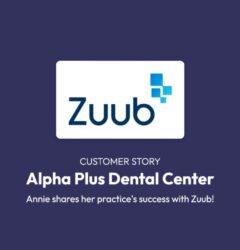Dental Insurance
Dental Guide to Implementing a Scalable Insurance Verification Process
25 May

As dental groups scale, each acquisition brings its own set of unique processes. Over time, the amount that has to be managed scales tremendously. While this makes it easy to veer from your group’s vision, there are some things you can do as a leader to help the organization stay on track with the increased number of people, processes, and technology flowing into the group.
This article intends to provide you with a guide for implementing a scalable insurance verification process that will help your RCM team operate more efficiently, redirect man-hours to revenue generation, and create a smoother integration process for new acquisitions. These recommendations will not be a one-size-fits-all approach, but rather critical items to think about as you are creating the playbook for your own group.
The Importance of a Process Audit
Regardless of how many locations you’re managing right now, before scaling to the next tier, you’ll want to make sure your current processes for insurance verification are optimized for efficiency. The goal here is to build a solid foundation for your group to build from.
The biggest gains in efficiency today are coming from technology that helps save your team time, retain and acquire talent, and maximize your human capital. Many aren’t yet aware of the impact technology has had on insurance verification, which puts the first movers at an advantage. Below are a few questions to ask as you are analyzing how much technology is impacting your insurance verification process.
- Do we use technology to automate the running of our insurance verifications?
- Are there staff members that spend 50%+ of their day on the phone with insurance companies?
- Is it a heavily manual process for my staff where they are logging into a portal for each patient to get a breakdown?
If you answered yes to some or all of these questions, there are areas where technology can optimize your insurance verification process. In the past 12 months alone insurance verification technology has progressed leaps and bounds. For groups that are taking advantage of this technology, their staff comes into the office each day with the verifications for that day’s appointments already run and accounted for – verifications done in real-time or scheduled ahead of time. Breakthroughs such as these have reduced time spent on the phone with insurance by 70-90%, on average.
The other tedious part of the process is navigating insurance portals to obtain benefits breakdowns. The software can also automate the full-length process of logging into the portal, obtaining the benefits breakdown, and uploading it to the patient’s file. If your RCM staff didn’t have to log into insurance portals anymore, how much compounded time savings does that generate across 25 practices? 50 practices? 100+ locations? The groups with a competitive advantage are redirecting these man-hours to revenue generation. They look at small time savings measures like how investors leverage compounded interest. Five minutes saved per verification x 30 verifications per practice x 25 locations. That’s 62.5 hours saved for this organization….in one day!
Organizing a Structure For Insurance Verifications
As you are creating your insurance verification playbook, another big foundational piece that should be accounted for before scaling is your structure for running insurance verifications. Meaning who will be accountable for it at each location. There is no correct answer to this question. It will be different for every organization. However, there are three main organizational structures in the industry.
-
Fully Centralized
Insurance verification is 100% taken off the plate of front office teams. The group brings this in-house and utilizes a central business office to run the full-length insurance verification process. This is most popular among specialist groups such as orthodontic support organizations (OSO). This structure lends itself well to homogenous groups that tend to run insurance verifications needing (mostly) the same data points for each practice.
-
Fully Distributed
The opposite of fully centralized. The responsibility for running insurance verifications is 100% at the front office level. Most popular among dental partnership organizations (DPO) where clinical autonomy is at the forefront of the organizational vision. This approach provides the flexibility necessary for each practice to maintain the unique clinical value that it brings to the organization.
-
Hybrid
A specialized approach based on the particular goals of an organization. Is there a priority around removing insurance calls from the front desk, while understanding there may be a necessity to engage insurance around new patients or emergency/walk-ins? This may be a solution that utilizes a central business office to support 90% of the process and equips the front office with tools to manage the other 10% efficiently. Where groups see the largest impact is in situations where technology is leveraged to automate as much as possible while layering in a centralized team to support where more attention is needed. The result is teams being freed up and redirected to A/R or filling the schedule. For those that have full-time employees dedicated to insurance verification, those employees can go from covering one office to four, leveraging technology to produce a force multiplier effect.
It’s important to reiterate that every group is different. The method that’s best for your group may not even fall into one of these three categories. Determining the best structure for your group will require collaboration at the organizational level and practice level to see what makes sense. The important thing is that you have a structure formed before writing the playbook and scaling it.
Creating the Playbook
The last critical foundational piece needed before scaling an insurance verification process is a playbook where best practices can be communicated en masse. These best practices are your vision for how you will interact with practices for the purposes of insurance verification.
Are you an “Every code, every patient, every payer, every visit,” kind of organization? Or do you update coverage tables once, twice, or four times a year? Is it ok if every office has its own long-form and enters data into the practice management system their own way, or would you like to see a standardized process for gathering and applying information across locations? Answers to these questions impact the kind of decisions you’ll make around your RCM solution stack and how your business will scale in relation to those goals.
As the organization is scaling, it’s also critical for business development teams to be educated on this process so that they can scale to the desired outcome and effectively communicate the vision and process to potential acquisitions. Bringing new partners into the fold that share in your vision goes a long way in helping your vision stick across the organization. With that comes operational efficiency and increased revenue and profitability.
If you’d like to learn more about Zuub’s automated dental insurance verification process click the button below!
About Author

Jason has worked in the dental industry for over 10 years helping groups leverage technology to maximize limited resources. His areas of expertise are automation, revenue cycle management operations, analytics and marketing strategy. In his free time, Jason enjoys spending time outdoors with his wife and two dogs in addition to supporting all things Texas Longhorns (Hook ’em!).
Recent Posts
Join Thousands Of Happy Providers
Start maximizing your revenue today!
26%
Average increase in practice ‘s productivity
- Increase case acceptance
- 350+ payer integrations
- Collect more, faster
- Reduce A/R costs
- Full automation
- Live customer support
Ready to get started?
Your online account setup only takes minutes. If you have questions, contact us at (213) 645-2813

Support Hours:
6 AM to 5PM (PST)









